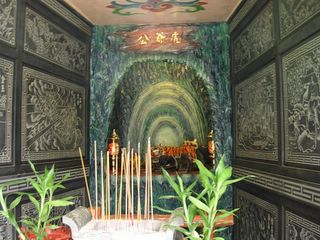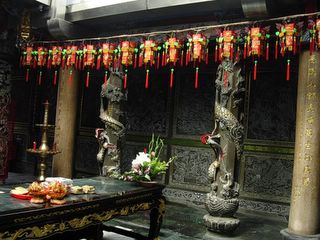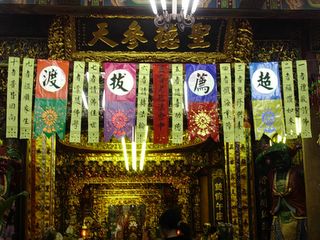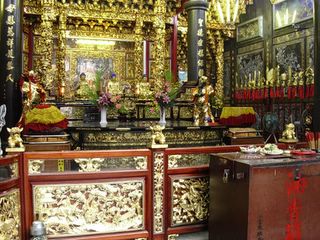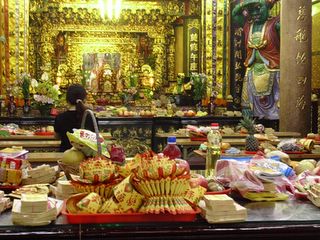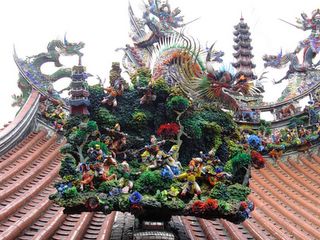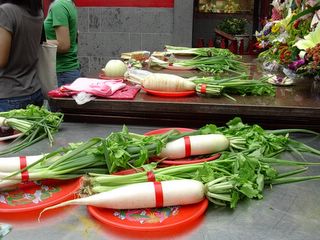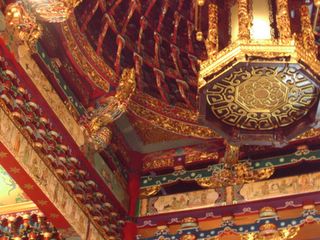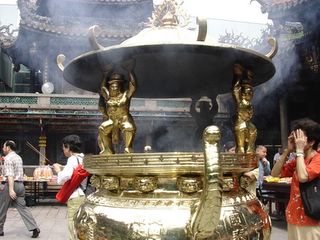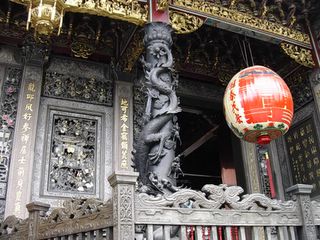My safe journey and return, in part, I owe to the gods and deities who guided and watched over me. Wherever I went, whenever I saw a temple, I would go inside and pray... a little gesture, but one that puts the mind at ease. Though I wouldn't say I'm religious (and Buddhism/Toaism is more a way of life than an actual religion), I do believe that all things I do and say will have consequences. The proverb 心誠則靈 (xin cheng zhe ling: when the heart is sincere, the spirit will be too) is the best way to describe it.
So yesterday afternoon I went to Lungshan Temple (龍山寺) in the district of Manka (艋舺). Originally established in 1738, it is one of the oldest temples in Taiwan, and its main shrine worships the Buddhist Goddess of Mercy (Guan Shi Yin Bu Sha 觀世音菩薩). Throughout time, local deities and gods and goddesses have been added in the outer walls which surround the main shrine, including the Goddess of Marine Voyage, Matsu 媽祖, Gods of Literature (文昌帝君, also known as the God of Examinations), the God of War (關聖帝君), and many others. Various dragon carving line the walls and totem poles, in beige, black and wood. During the Second World War, while all the surroundings were destroyed as a result of Allied bomb (a strategy to force the Japanese to surrender), the shrine containing the Goddess of Mercy miraculously remained unscathed.
Later on, I also visited Eng Hui Temple (恩惠宮) across the river in Banciao (板橋), which is dedicated to the Goddess of Marine Voyage, Matsu. This temple is also where my mum asked Matsu to be my godmother, so it has a very special meaning whenever I visit.
Temples are always fascinating places to visit. It is here that people from all walks of life congregate, with one (or more) hopes and wishes in mind. One could say Taiwanese local religion is one which is praticed whenever the need arises. There are no strict religious ettiquets which need to be performed daily, there are no strict dietary prohibitions (though some people swear off meat, or just beef), and there are no strict dress codes. Basically, the local religion is one which people adhere to when they feel like it. So visiting temples becomes an activity performed only when there is a purpose, like going shopping when you need something... maybe there are examinations soon, maybe someone has been having a string of bad luck, maybe the family business is not doing so well, or maybe someone is about to travel to a place far away, or perhaps a woman wants to conceive a child, or maybe one wishes to convey well-wishes to loved ones who have gone beyond this world... all sorts of prayers, hopes and dreams congregate at temples. Incence sticks are burnt, and worshippers stand in front of the statues of the gods, goddesses and deities, bow with respect and shake the incence sticks up and down, while muttering their hopes and wants. Then, the sticks are planted into giant pots...people say the whifts of smoke and pungent air which rise up toward the heavens are supposed to convey the messages to the gods and deities watching and listening above. Giant candles are also lit, while offerings of food, drinks, snacks, fruits and other foods and drinks with symbolic value are placed in front of the statues of the gods as a show of sincerity. Later, these foods and drinks are taken away as the worshipper leaves the temples. Occassionally, as further shows of sincerity and respect, paper money is burnt in giant urns.
In Taiwanese temples, there are always rooms on the side which house giant colemns and walls of lit bulbs. These light bulbs are known as 'Light of Light and Brightness' 光明燈, and can be purchased for a small price. According to the Chinese animal zodiac, there are times when things go well, and there years when things are not so well...and it all depends on the alignment of the moon and stars, as well as the animal which represents the year. So for a rat (like me), the year of the monkey (last year) was a supposedly a bad year (overall, it seemed alright). A lit bulb, with my name written on the front is supposed to offer guidance and 'enlightenment' wherever I go and am, as I pass through the bad year.
As monks chanted sutras, groups of worshippers old and young shifted from altar to altar, as Japanese and other foreign tourists admired the magnificent decors, caligraphed walls and delicately carved dragon poles, the gods closed their eyes and sat serenely on their raised stools.
Thursday, July 21, 2005
Subscribe to:
Posts (Atom)





